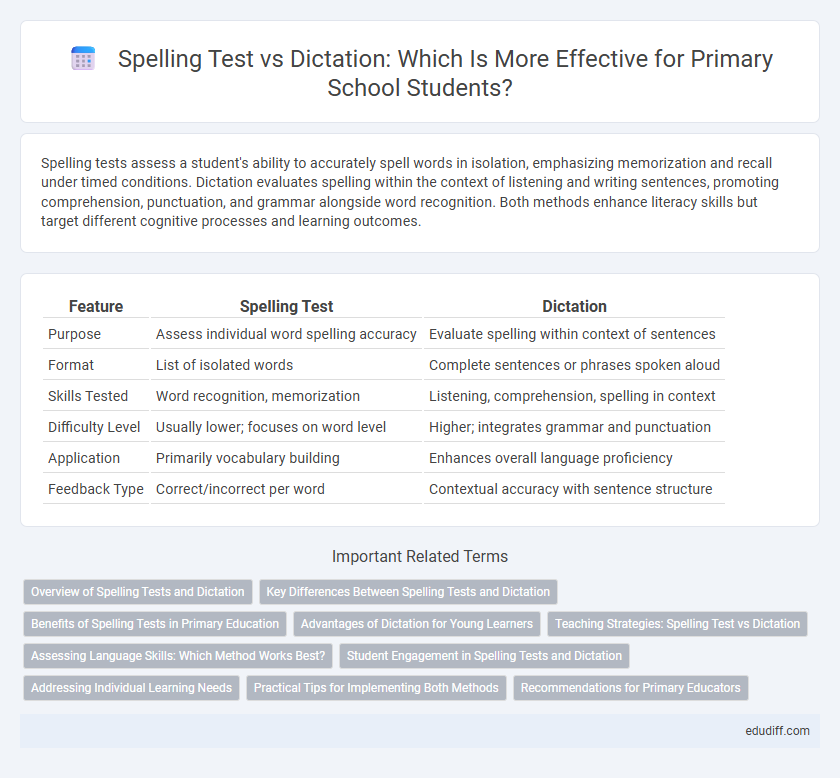Spelling tests assess a student's ability to accurately spell words in isolation, emphasizing memorization and recall under timed conditions. Dictation evaluates spelling within the context of listening and writing sentences, promoting comprehension, punctuation, and grammar alongside word recognition. Both methods enhance literacy skills but target different cognitive processes and learning outcomes.
Table of Comparison
| Feature | Spelling Test | Dictation |
|---|---|---|
| Purpose | Assess individual word spelling accuracy | Evaluate spelling within context of sentences |
| Format | List of isolated words | Complete sentences or phrases spoken aloud |
| Skills Tested | Word recognition, memorization | Listening, comprehension, spelling in context |
| Difficulty Level | Usually lower; focuses on word level | Higher; integrates grammar and punctuation |
| Application | Primarily vocabulary building | Enhances overall language proficiency |
| Feedback Type | Correct/incorrect per word | Contextual accuracy with sentence structure |
Overview of Spelling Tests and Dictation
Spelling tests evaluate a student's ability to correctly write words based on memorization and recognition of spelling patterns. Dictation exercises assess listening comprehension and transcription skills by requiring students to write down passages or sentences dictated to them. Both methods are essential for developing literacy, with spelling tests emphasizing accuracy in spelling and dictation supporting auditory processing and writing fluency.
Key Differences Between Spelling Tests and Dictation
Spelling tests assess students' ability to accurately spell individual words, emphasizing memorization and recall of correct letter sequences. Dictation requires students to write down complete sentences or passages as they are read aloud, testing both spelling and listening comprehension skills. The key difference lies in dictation's integration of context and syntax, while spelling tests isolate word-level spelling proficiency.
Benefits of Spelling Tests in Primary Education
Spelling tests in primary education enhance students' vocabulary retention by encouraging active recall of words and their correct letter sequences, which strengthens neural pathways associated with language. Regular spelling assessments improve phonemic awareness and decoding skills, essential for reading proficiency and literacy development. Structured spelling tests also provide measurable feedback, enabling targeted intervention to address individual learning gaps effectively.
Advantages of Dictation for Young Learners
Dictation enhances young learners' listening and writing skills by reinforcing accurate spelling through active engagement. It promotes auditory discrimination and memory retention, helping children internalize correct word forms and sentence structures. This method also boosts concentration and develops the ability to process language in real time, making it a valuable tool for primary education.
Teaching Strategies: Spelling Test vs Dictation
Effective teaching strategies for spelling tests emphasize memorization, repetition, and visual recognition of word patterns, helping primary students internalize correct spellings. Dictation enhances auditory processing and reinforces spelling through real-time application, encouraging students to connect sounds with letters and improve listening skills. Combining both approaches creates a comprehensive learning experience that addresses multiple cognitive processes essential for robust spelling proficiency.
Assessing Language Skills: Which Method Works Best?
Spelling tests primarily assess students' ability to recognize and reproduce correct word forms, focusing on orthographic skills and memory recall. Dictation evaluates broader language competencies, including listening comprehension, punctuation, grammar, and syntactic structure, providing a more comprehensive measure of linguistic proficiency. Research suggests dictation often yields a more accurate assessment of overall language skills in primary education, as it integrates multiple language domains simultaneously.
Student Engagement in Spelling Tests and Dictation
Student engagement in spelling tests often increases with interactive and gamified activities that encourage active participation and immediate feedback. Dictation fosters deeper focus on listening skills and spelling accuracy by requiring students to process and transcribe spoken words in real time. Both methods enhance vocabulary retention and reinforce phonetic rules, but incorporating varied formats can sustain motivation and improve overall learning outcomes.
Addressing Individual Learning Needs
Spelling tests provide a structured way to assess a student's ability to recall and reproduce specific word patterns, helping identify areas of difficulty in phonics and vocabulary. Dictation exercises engage multiple skills simultaneously--listening, comprehension, and writing--offering a comprehensive insight into a learner's language processing abilities. Tailoring these assessments to individual proficiency levels ensures targeted support, effectively addressing diverse learning needs in primary education.
Practical Tips for Implementing Both Methods
Spelling tests enhance vocabulary retention through active recall, while dictation improves listening comprehension and contextual understanding. To implement both methods effectively, schedule regular short sessions, use age-appropriate word lists, and provide immediate feedback to reinforce learning. Incorporate varied sentence structures during dictation to challenge students and boost their spelling accuracy under real-world conditions.
Recommendations for Primary Educators
Primary educators should integrate both spelling tests and dictation exercises to reinforce phonetic awareness and vocabulary retention. Tailoring difficulty levels and incorporating student-centered feedback promotes engagement and improves literacy outcomes. Emphasizing consistent practice with contextualized words aligns with language development best practices in primary education.
Spelling Test vs Dictation Infographic

 edudiff.com
edudiff.com